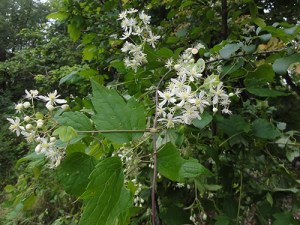
Virgin’s bower (Clematis virginiana) is a native vine that grows throughout much of the eastern two thirds of the country. As the scientific name suggests, this is a native clematis and related to the exotic clematises that are common in the horticulture trade.
In the wild, virgin’s bower is most often found along streambanks or in semi-open, moist woods. However, in landscaped settings it can grow in sunny to partly sunny areas and moist to medium soils. Virgin’s bower can grow up to 20 feet long and will twine itself around bushes, small trees, up a trellis, or just sprawl across the ground. Trimming it to a foot and a half to two feet tall in the late winter can encourage it to grow back in a shorter, bushier form the next year.
Virgin’s bower produces multiple clusters of bright white flowers in the summer and early fall. (Typically, June through September in Kentucky.) The flowers are highly attractive to honey bees, many species of native bees, and several species of butterflies. The caterpillars of several moths, including the clematis clearwing moth (Alcathoe caudate), feed on the foliage. Songbirds will also nest in the thick foliage which tends to be relatively deer resistant.
Virgin’s bower spreads by seeds and by root suckers. The seeds are attached to tufts of “fluff.” The fluff can be relatively long and the seed heads can sometimes be almost as showy as the flowers. Eventually, the seeds will be dispersed by the wind. Due to the number of seeds it produces and the fact that it can also spread by root suckers, virgin’s bower can sometimes spread aggressively in garden settings.

The leaves of virgin’s bower consist of three leaflets that have jagged or serrated edges. At first glance, they kind of remind me of a not-quite-right poison ivy leaf or not-quite-right maple leaves. Being able to recognize the leaves is important because otherwise virgin’s bower looks very similar to an invasive species, sweet autumn clematis (Clematis terniflora), which is often sold in the nursery industry. Instead of the jagged / serrated edges of the leaves found on virgin’s bower, the leaves of sweet autumn clematis have smooth edges and are more oval shaped.
In Kentucky, sweet autumn clematis is considered a severe threat by the Kentucky Exotic Plant Pest Council and several other states in this region also list it as invasive. Even though sweet autumn clematis can be found in many nurseries, please do not plant it due to its invasive nature. Instead, if you want a similar-looking, summer to fall blooming clematis, please consider our native virgin’s bower.

This article was part of Shannon’s original Kentucky Pollinators and Backyard Wildlife blog which evolved into the blog for Backyard Ecology.

Backyard Ecology: Exploring Nature in Your Backyard
Nature isn’t just “out there.” It’s all around us, including right outside our doors. Hi, my name is Shannon Trimboli, and I am the host of Backyard Ecology. I live in southcentral Kentucky and am a wildlife biologist, educator, author, beekeeper, and owner of a nursery specializing in plants for pollinators and wildlife conservation. I invite you to join me as we ignite our curiosity and natural wonder, explore our yards and communities, and improve our local pollinator and wildlife habitat. Learn more or subscribe to my email list at www.backyardecology.net.

Leave a Reply